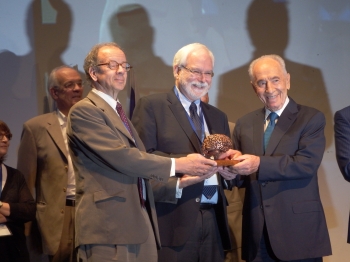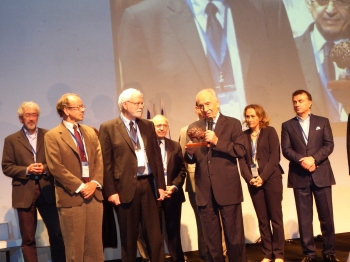President Peres presented the million dollar Breakthrough Research and Innovation in Neurotechnology (B.R.A.I.N) prize to Brain Gate Research and Development for the creation of robotic arms for disabled people which are controlled by neural sensors
President Peres to the BrainGate team:
"Israel can become a world leading start-up nation in brain research. Just as we are world leaders in nanotechnology so we can become leaders in brain research"
The President of the State of Israel, Shimon Peres, presented a million dollar prize this morning to BrainGate Research team for groundbreaking research in neurotechnology (The Breakthrough Research and Innovation in Neurotechnology - B.R.A.I.N) at the international Braintech Israel 2013 Conference, hosted by Israel Brain Technologies (IBT), a non-profit organization inspired by the vision of President Peres. IBT is headed by Rafi Gidron and was founded in 2011 with the aim of making Israel a hub for brain research.
BrainGate provides hope for disabled people all over the world through the creation of robotic and prosthetic arms which are controlled by neural sensors. The development is at the cutting edge of brain research which can allow disabled people to walk again and regain use of their arms. The 10 finalists are from some of the world's leading institutions including MIT, Brown, UCLA, UCSF as well as Israeli researches from top universities and businesses in the field of healthcare. The finalists were chosen from 70 projects, from 11 countries across the world.
Upon presenting the prize President Peres said, "It’s a privilege to present this prize. It is the result of hard work. Personally I'm excited because a few years ago we turned Israel into a world leader in nanotechnology and now we must do the same with neurotechnology and brain science research. "Israel can become a world leading start-up nation in brain research. Just as we are world leaders in nanotechnology so we can become leaders in brain research"
The 10 Brain Prize Finalists:
Dr. Hagai Bergman
We have shown that closed loop adaptive deep brain stimulation (DBS) of the basal ganglia (the part of the brain which is affected during Parkinson’s and other brain diseases) is superior to current stimulation methods. We conclude that the basal ganglia can be observed and controlled, and suggest that closed loop adaptive DBS is the optimal treatment for a range of severe basal ganglia disorders including Parkinson’s disease, depression, obsessive-compulsive disorders and schizophrenia.
Dr. Edward Boyden, MIT
The brain is made out of an incredible number of cell types, which change in different ways to cause diseases, raising the question of how to identify optimal targets in the brain for therapeutic purposes, as well as how to resculpt the dynamics of the brain for clinical benefit. We propose to adapt a technology that we and our collaborators developed earlier, optogenetics, which enables cells to be activated and silenced by light, towards the systematic identification of clinically relevant targets in the brain, and towards deployment as a fundamental new neuromodulation technique for treating brain disorders.
BrainGateTeam Led by Dr. John Donoghue
The BrainGate Research and Development team, based at Brown University with collaborators at the Massachusetts General Hospital, the Department of Veterans Affairs Medical Center (Providence, Rhode Island), Case Western Reserve University, and Stanford University, has demonstrated the first human uses of an implanted neural sensor and neural interface system to control robotic and prosthetic arms in three-dimensional space, in one case by a woman with tetraplegia who served herself a bottle of coffee nearly 15 years after a stroke. The BrainGate research, which previously resulted in the first human neural control of a computer cursor, has enabled a new understanding of human brain function and the development of a novel, fully-implanted platform neurotechnology capable of wirelessly transmitting large numbers of neural signals from multiple types of sensors for use in Brain Computer Interface, epilepsy monitoring, and neuromodulation applications.
ElMindA&Soterix (Collaboration)
About one third of the world’s population suffers from acute or chronic pain with the effects of pain exact a tremendous cost on health systems and impose emotional and financial burden on patients. Diagnostic and clinical management of pain still heavily rely on clinical symptoms and patient’s subjective reporting while the common treatment for pain is not based on personally customized pain relief. The proposed project (based on a multi-national collaboration) aims to develop a closed loop pain treatment platform, with the goal of offering a focused, specific and personalized approach for the effective treatment of pain.
Dr. Itzhak Fried
Brain pacemaker to treat memory impairment in early Alzheimer’s Disease and other memory disorders including traumatic brain injury, epilepsy and stroke. Neurotechnology is based on site-specific, on-demand brain stimulation coupled to information processing and regulated by neural signal feedback.
Inscopix
Research on brain disease stands poised to achieve conceptual breakthroughs due to recent technological advances. There are now mice that provide models of human disease for study, tools to target specific brain regions, and ways to adjust certain patterns of brain functioning. However, science has yet to uncover the normal patterns of neural dynamics and how these go awry in disease states. Dr. Mark Schnitzer and the company he co-founded, (with Drs KunalGhosh and Abbas El Gamal) InscopixInc, have created a technology to fill this gap by providing the necessary data to guide therapeutic strategies for re-tuning neural dynamics. Specifically, Inscopix has created brain imaging devices for use in freely behaving mice, by using mass producible optoelectronics, thereby enabling researchers to observe the dynamics of large numbers of individual, genetically identified neurons and in many mice in parallel. This innovation will yield crucial knowledge of how circuit dynamics differ between normal and diseased brains, a key toward creating corrective strategies.
Insightec
Focused ultrasound enables focal effects in the brain with sub millimeter accuracy with no impact to surrounding tissue using MRI image guidance.It is currently applied to the treatments of movement disorders (Parkinson’s and Tremor).Beyond that it is being evaluated as the world first noninvasive deep brain focused Neuromodulation technology which will revolutionize our understanding of the human brain.
Nano-Retina
Interfacing with retinal neurons, Nano Retina’s artificial retina prosthesis is designed to use the natural mechanisms of the eye to convert images into neural stimulation. Neural stimulation is delivered through more than 600 electrodes, which can be recognized by the brain, thereby restoring vision to persons blinded by retinal diseases, such as macular degeneration.
Dr. Andrew Schwartz
In the last 30 years we have developed an effective approach for decoding the intention component of volitional movement. Using these results, we have now demonstrated the ability to translate recorded brain signals to coordinated, natural movement of a prosthetic arm and hand by a quadriplegic individual who uses this technology to perform tasks of daily living.
Team Led by Dr. Phillip Starr
By recording brain signals from the cortex in persons undergoing surgery for Parkinson’s disease, we recently discovered a biomarker of abnormal brain synchronization that can be detected using a clinically practical electrode that does not penetrate or damage brain tissue. Our next step is to utilize this signal to improve the effectiveness of neurostimulation therapies by incorporating feedback control.
Photos Silvia Golan











